- Главная
- Английский язык
- Kazakh national foods

Содержание
- 2. Мeat dishes: - Beshbarmak - Kuyrdak - Kazy - Karta -Shuzhuk In Kazakhstan, the main dishes
- 3. Kuyrdak The national dish of Kazakhs, who are ready immediately after slaughtering a sheep or a
- 4. Beshbarmak This is the main national dish of Kazakhs, without which no cost, no celebration. The
- 5. Kazy-Karta. Shuzhuk Kazy - Traditional horse meat sausage in a number of Turkic peoples, which is
- 6. Kazy-Karta Shuzhuk
- 7. Traditional bread Traditional bread three kinds: baursaks - fried in boiling oil in a cauldron round
- 8. Baursaks and Shelpek The most common are baursaks and shelpek, as they are easy to prepare
- 9. Baursaks Shelpek
- 10. Tandoor bread Tandoor bread, cakes tandyrnye traditional bread Central Asian peoples (Kazakhs, Kyrgyz, Uzbeks, Uighurs, Tajiks
- 11. Presentation by: Toleubekova Asia
- 12. В Казахстане основные блюда являются мясными. Среди них особое место занимает наиболее распространенное блюдо именуемое в
- 14. Скачать презентацию
Слайд 2
Мeat dishes:
- Beshbarmak
- Kuyrdak
- Kazy
- Karta
-Shuzhuk
In Kazakhstan, the main dishes
Мeat dishes:
- Beshbarmak
- Kuyrdak
- Kazy
- Karta
-Shuzhuk
In Kazakhstan, the main dishes
are meat. Among them is the most common dish called in Kazakh language «ет", which means in translation proper meat.
Слайд 3
Kuyrdak
The national dish of Kazakhs, who are ready immediately after slaughtering
Kuyrdak
The national dish of Kazakhs, who are ready immediately after slaughtering
a sheep or a cow. All products (usually included in the leaver) thoroughly washed, and after washing the lungs and stomach slightly boiled. Then finely chopped all the ingredients kuyrdak: lungs, liver, kidneys, stomach, a little meat (to give a hot taste).
Слайд 4
Beshbarmak
This is the main national dish of Kazakhs, without which no
Beshbarmak
This is the main national dish of Kazakhs, without which no
cost, no celebration. The name of the meat dishes originated from two words "Besh" (properly "demon") - five, and "Barmak" - a finger. The literal translation - symbolic, "five fingers". In nomadic times, our ancestors did not use cutlery. There was a strict ritual (he now observed when eating with his hands) when before serving meals to fit every guest a young man with a jug of warm water with a clean towel and basin, providing the ability to comfortably wash your hands before eating. Then Serve "beshbarmak", or it is also called "meat-Kazakh" (in Kazakh - "a"), which they ate with his hands. After the meal, be sure to hygienic procedure was repeated.
Слайд 5
Kazy-Karta. Shuzhuk
Kazy - Traditional horse meat sausage in a number of
Kazy-Karta. Shuzhuk
Kazy - Traditional horse meat sausage in a number of
Turkic peoples, which is considered a delicacy. Manufactured by getting your natural gut horse horse fat meat from the ribs (usually smear the meat with spices and herbs), with not stuffed with minced meat and meat seasoned with edge entirely, thereby obtaining a large semicircle. Often the edge is separated and inserted into the guts of meat with ribs in one piece. Commonly used meat to fat stripe thereon. Is used in various forms - sausage, boiled, cooked and povyalennom.
Karta - Colon (horse), turned inside out (inside fat). Prepared by washing and salting the weak. It is consumed in cooked form. It is also considered a delicacy among the Turkic peoples (Kazakhs, Tatars, Karakalpak)
Shuzhuk (KAZ shұzhyқ.) - For the production reminds kazi, but he used all the pieces of meat, not a piece of meat edged, also considered a gourmet meal.
Слайд 6
Kazy-Karta
Shuzhuk
Kazy-Karta
Shuzhuk
Слайд 7
Traditional bread
Traditional bread three kinds: baursaks - fried in boiling oil
Traditional bread
Traditional bread three kinds: baursaks - fried in boiling oil
in a cauldron round or square pieces of dough, tandyrnye cakes - baked on the inside of the oven and tandyrnoy shelpek - tortillas are fried in boiling oil.
Слайд 8
Baursaks and Shelpek
The most common are baursaks and shelpek, as they
Baursaks and Shelpek
The most common are baursaks and shelpek, as they
are easy to prepare in field conditions - in a cauldron, and today is traditionally prepared for any celebration undoubtedly being an additional decoration of the festive table, while as tandyrny bread requires tandyrnyh oven and bake it mainly in settled areas (cities on the Great Silk Road, some winter pastures with nomad camps (kystau - winter hut), is now more common in rural areas.
Слайд 9
Baursaks
Shelpek
Baursaks
Shelpek
Слайд 10
Tandoor bread
Tandoor bread, cakes tandyrnye traditional bread Central Asian peoples (Kazakhs,
Tandoor bread
Tandoor bread, cakes tandyrnye traditional bread Central Asian peoples (Kazakhs,
Kyrgyz, Uzbeks, Uighurs, Tajiks and Turkmen) in the form of cakes, cooked in a traditional oven - tandoor. The usual composition of cakes - wheat flour, water, yeast, milk, margarine, sesame seeds, poppy.
Слайд 11
Presentation by: Toleubekova Asia
Presentation by: Toleubekova Asia
Слайд 12
В Казахстане основные блюда являются мясными. Среди них особое место занимает
В Казахстане основные блюда являются мясными. Среди них особое место занимает
наиболее распространенное блюдо именуемое в казахском языке "ет", что означает в переводе собственно мясо.
Это главное национальное блюдо казахов, без которого не обходится ни одно торжество. Название этого мясного блюда произошло из двух слов «беш»(правильно «бес») – пять, и «бармак» – палец. Дословный перевод – символический, «пять пальцев». В кочевые времена наши предки не пользовались столовыми приборами. Существовал строгий ритуал (он и сейчас соблюдается , если кушают руками), когда перед подачей блюда к каждому гостю подходит юноша с кувшином теплой воды с тазиком и чистым полотенцем, предоставляя возможность комфортно помыть руки перед едой. Затем подавалось блюдо «бешбармак», или его еще называют «мясо-по-казахски» (по-казахски – “ет”), которое кушали руками. После трапезы обязательно гигиеническая процедура повторялась.
Национальное блюдо казахов, которое готовили сразу после забоя барана или коровы. Все субпродукты (обычно входящие в ливер) тщательно промываются, а после промывания легкие и желудок немного отвариваются. Затем мелко рубятся все ингредиенты куырдака: легкие, печень, почки, желудок, немного мяса (для придания вкуса жаркого). Казы́ — традиционная колбаса из конины у ряда тюркских народов, считающаяся деликатесом. Изготавливается путём набивания натуральной конской кишки конским жирным мясом с рёбер (обычно обмазав мясо пряностями и специями), причём набивают не фаршем, а заправляют мясо с ребром целиком, получая таким образом большое полукольцо. Зачастую ребро отделяется и в кишки вставляется мясо с ребра целым куском. Обычно используется мясо с полосой жира на нем. Употребляли в разных видах — сырокопчёном, варёном, повяленном и отваренном.
Карта́ (башк. ҡарта, каз. қарта) — толстая кишка (конская), вывернутая наизнанку (жиром внутрь). Готовится путём промывки и слабого засаливания. Потребляется в варёном виде. Также считается деликатесом у тюркских народов (казахов, татар, каракалпаков)
Шужу́к (каз. шұжық) — по изготовлению напоминает казы, но для него используются любые куски мяса, а не рёберное мясо куском, также считается деликатесным блюдом.
Это главное национальное блюдо казахов, без которого не обходится ни одно торжество. Название этого мясного блюда произошло из двух слов «беш»(правильно «бес») – пять, и «бармак» – палец. Дословный перевод – символический, «пять пальцев». В кочевые времена наши предки не пользовались столовыми приборами. Существовал строгий ритуал (он и сейчас соблюдается , если кушают руками), когда перед подачей блюда к каждому гостю подходит юноша с кувшином теплой воды с тазиком и чистым полотенцем, предоставляя возможность комфортно помыть руки перед едой. Затем подавалось блюдо «бешбармак», или его еще называют «мясо-по-казахски» (по-казахски – “ет”), которое кушали руками. После трапезы обязательно гигиеническая процедура повторялась.
Национальное блюдо казахов, которое готовили сразу после забоя барана или коровы. Все субпродукты (обычно входящие в ливер) тщательно промываются, а после промывания легкие и желудок немного отвариваются. Затем мелко рубятся все ингредиенты куырдака: легкие, печень, почки, желудок, немного мяса (для придания вкуса жаркого). Казы́ — традиционная колбаса из конины у ряда тюркских народов, считающаяся деликатесом. Изготавливается путём набивания натуральной конской кишки конским жирным мясом с рёбер (обычно обмазав мясо пряностями и специями), причём набивают не фаршем, а заправляют мясо с ребром целиком, получая таким образом большое полукольцо. Зачастую ребро отделяется и в кишки вставляется мясо с ребра целым куском. Обычно используется мясо с полосой жира на нем. Употребляли в разных видах — сырокопчёном, варёном, повяленном и отваренном.
Карта́ (башк. ҡарта, каз. қарта) — толстая кишка (конская), вывернутая наизнанку (жиром внутрь). Готовится путём промывки и слабого засаливания. Потребляется в варёном виде. Также считается деликатесом у тюркских народов (казахов, татар, каракалпаков)
Шужу́к (каз. шұжық) — по изготовлению напоминает казы, но для него используются любые куски мяса, а не рёберное мясо куском, также считается деликатесным блюдом.
- Предыдущая
Present simple tenseСледующая -
Giving directions in the game


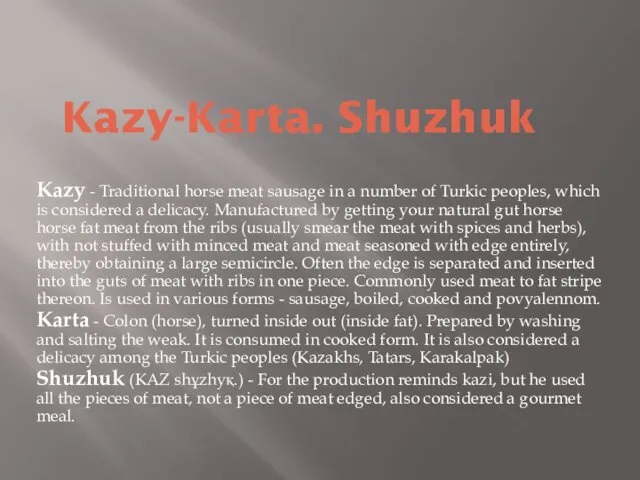
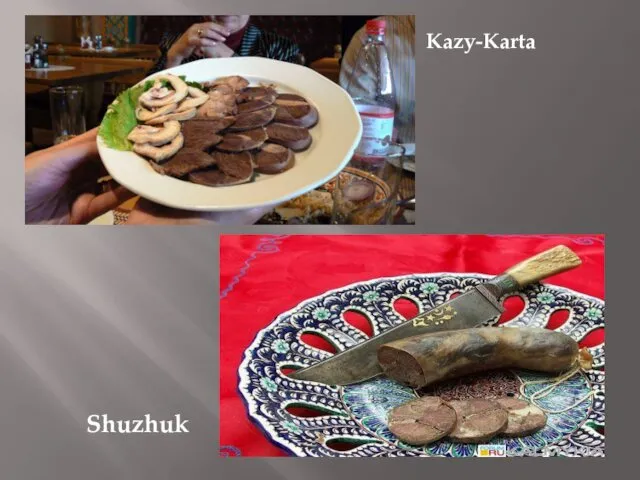
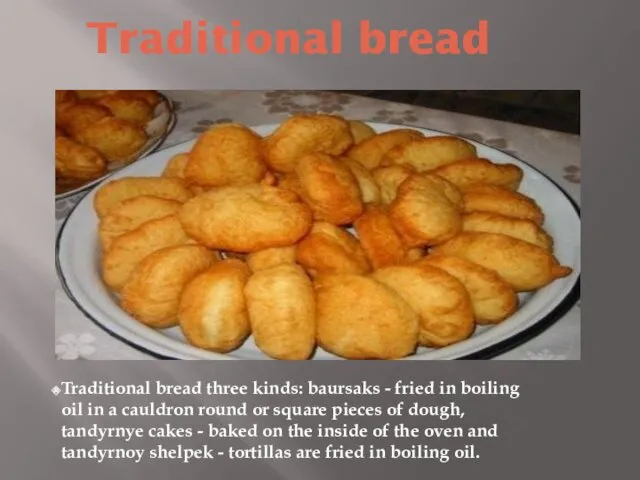

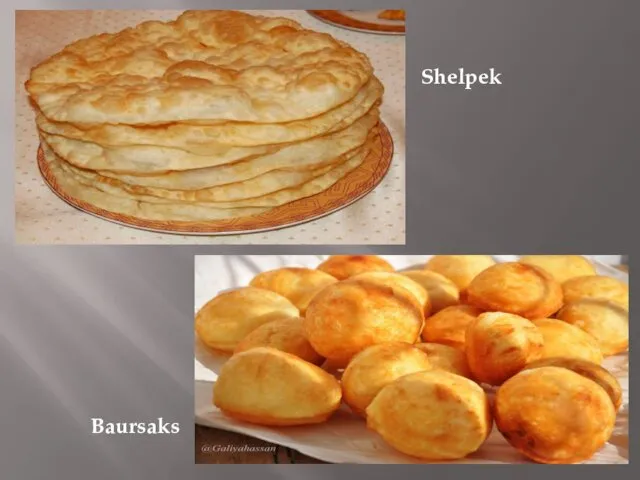
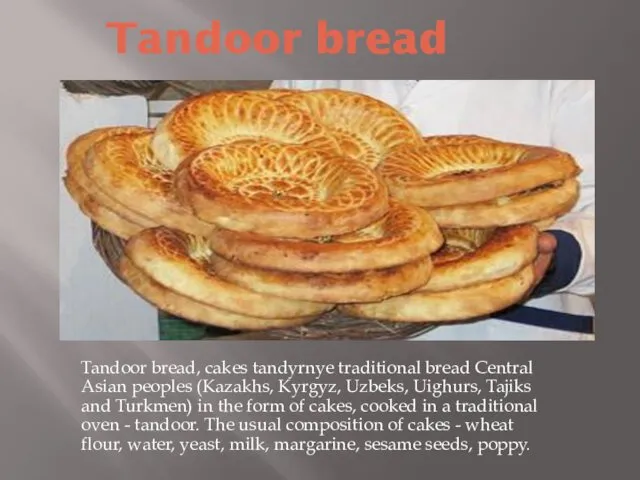

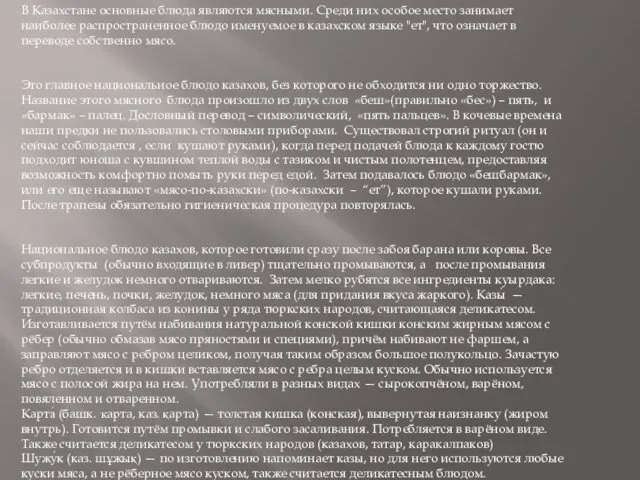
 Irregular verbs
Irregular verbs Colours
Colours My hobby and future profession
My hobby and future profession Letter
Letter World animals. Module 5. Extensive Reading 5. Science. Insects
World animals. Module 5. Extensive Reading 5. Science. Insects November 30th
November 30th Winter holidays
Winter holidays Some Practical Assignments for Stylistic Analysis
Some Practical Assignments for Stylistic Analysis Lexicology as a branch of linguistics
Lexicology as a branch of linguistics Лексические трансформация
Лексические трансформация Reported speech. Косвенная речь
Reported speech. Косвенная речь My pet
My pet г. have_got_has_got
г. have_got_has_got Riddles
Riddles A comparative overview of Turkmen and Belarusian Cultures “Business Rituals”
A comparative overview of Turkmen and Belarusian Cultures “Business Rituals” British Royal Family
British Royal Family Prepositions of time
Prepositions of time Present Simple Tense (настоящее простое время)
Present Simple Tense (настоящее простое время) Welcome to cad/cam services
Welcome to cad/cam services Языковой лагерь English drive
Языковой лагерь English drive Maslenitsa
Maslenitsa Presentation about caviar. The food of the tsars
Presentation about caviar. The food of the tsars Education in Sakha Repubic
Education in Sakha Repubic The Republic of Tatarstan is a subject of the Russian Federation
The Republic of Tatarstan is a subject of the Russian Federation Meals and snacks
Meals and snacks The most unusual work in the World
The most unusual work in the World Elite Las Vegas Escorts
Elite Las Vegas Escorts Propaganda and Freedom in Mass Media
Propaganda and Freedom in Mass Media